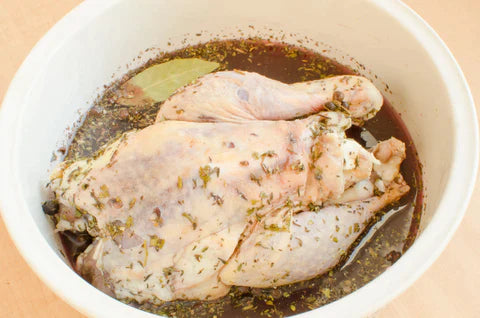Though popularly linked with smoking turkey over Thanksgiving, brining is not only for turkey. You can also brine chicken, fish, pork, and beef. It goes perfectly with these different types of meat, enhancing their natural flavors.
What is Brining?
Brining is the technique of infusing salt, sugar, and flavor into protein. It also softens and hydrates the meat. The proteins are usually steeped in a water solution or any other liquid, such as apple juice, wine or beer salt, and spices, and then kept in the refrigerator for several hours.
Previously, brining was used to preserve meat and seafood without refrigeration, dating back an estimated thousands of years. But with the invention of the refrigerator, brining is done today purely to enhance flavor and texture.
Brining works so that when the meat and salt come into contact, the salt causes the meat’s protein strands to unravel. Moisture becomes trapped between the strands when this happens. As a result, they adapt their structure over time, become entangled with one another, and trap moisture.
Many pitmasters often endorse brining for any smoking process not only for its ability to enhance flavor but also for its role in ensuring the meat remains succulent. Remember, smoking forces moisture out of the meat, drying it out. But with the extra moisture, you can quickly and comfortably smoke your favorite cut of meat without any worries.

Types of Meat to Brine
Any meat that will be cooked for an extended period tends to dry out. Pork and poultry are common examples. Certain larger portions of beef, such as brisket, can be brined, but it isn’t required. Beef includes connective tissue and fat throughout, which breaks down while the meat cooks, which keeps it from drying out.
Because the meat would dry out throughout a long cooking process, lean cuts of any animal are ideal. Poultry does not have a lot of fat, which is why it might dry out quickly.
If you are a meat lover, you must have noticed that dark chicken meat is usually more tender and juicy than white meat. The reason behind this usually depends on whether the meat has been brined or not. You can establish this because dark flesh contains more fat.
Wet Brining
When wet brining, a gallon of water and one cup of kosher salt are combined to make a solution. The aim is to add flavor and moisture to red meat, chicken, and fish. For other non-essential items, soak them in a solution of salt, liquid, and perhaps additional non-essential components.
Pieces of meat, such as chicken or turkey, acquire weight throughout the wet brining process. When brined test subjects are cooked alongside non-brined test subjects of identical size and weight, the brined test subjects will be heavier when cooked.
This excess weight is water that has become trapped in the meat during the cooking process and was unable to be forced out by the heat. When you cut into it, it’ll be particularly juicy.

Advantages of Wet Brining
- More succulent, tender, and juicy meat: Wet brining allows more juices to soak into the meat, which is vital in ensuring the meat retains moisture and succulence.
- Makes it easier to smoke: Wet brined meat is always easy to smoke as it reduces the possibility of your meat drying out. However, you will also need to pay close attention to both internal and external temperature to avoid undercooking and overcooking.
Dry Brining
Dry brining involves applying salt to the surface of the meat. This is done to block moisture from potentially escaping during the smoking process. It’s also done to enhance the meat’s natural flavor. In most cases, a half teaspoon is enough for close to a pound of meat.
The salty brine is eventually absorbed into the meat. Dry brining takes a few hours to complete.
The salt in the brine causes the steak to go through the same denaturing process, trapping the reabsorbed moisture between the protein strands. Due to containing water that cannot be easily squeezed out during cooking, a dry brined cut of meat, like chicken or turkey, for example, ends up with more preserved moisture than a non-dry brined cut.

Advantages of Dry Brining
- Natural flavor
Salt is known as a universal flavor in food smoking circles as it can be used on all types of meats. Applying salt on the meat’s surface doesn’t alter the meat’s internal juices but only blocks it from escaping during smoking, giving you a detailed natural taste.
- Firm, tender, and well-cooked outcome
Meat and fish that have been dry-brined and cooked come out wonderfully juicy and firm. Salt’s nutrient magic will take time to work, allowing the meat to retain its balance of moisture while cooking.
- Easy to brine
Brining your meat can be made easy by applying salt on the surface. The key is to observe the recommended amount for excellent results.
Regardless of the method you use to brine, always remember to allow the meat to sit for a few hours. After this, you can transfer your meat directly into the food smoker. We recommend tossing the meat into the smoker without rinsing it as it will dilute the brine.
Check out our entire catalog of articles on brining and curing your meat here:
What’s the Difference Between Pickling, Brining, Marinating, and Curing?
Curing and Smoking Meats for Home Food Preservation
Directions On Brining And Curing Your Meat For Food Smoking





